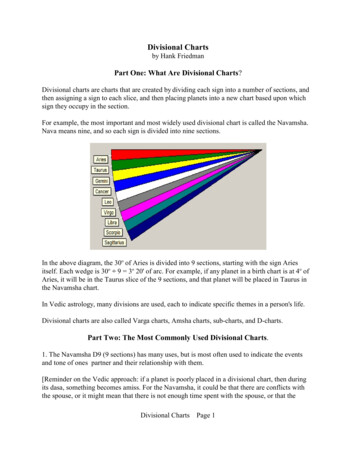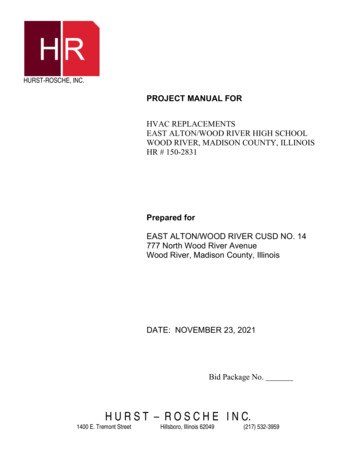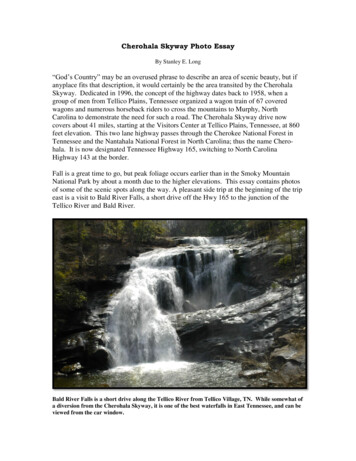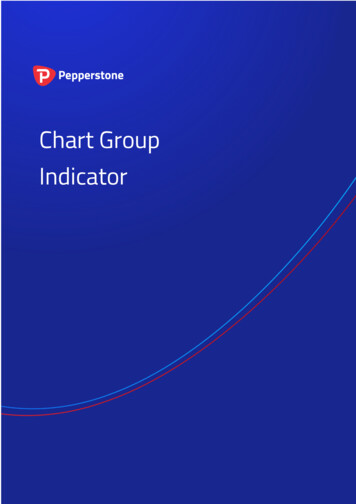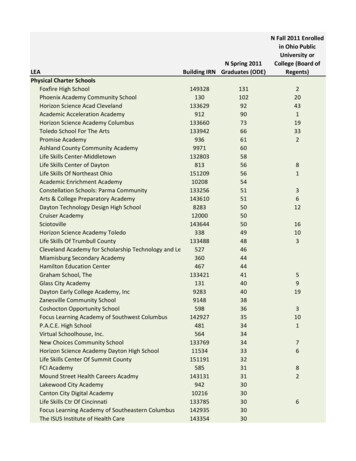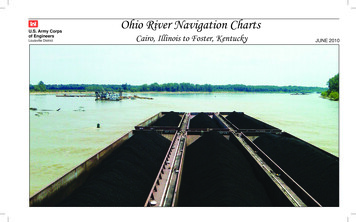
Transcription
U.S. Army Corpsof EngineersLouisville DistrictOhio River Navigation ChartsCairo, Illinois to Foster, KentuckyJUNE 2010
NAVIGATION CHARTS AND NOTICESMile points are shown on the charts atone mile intervals beginning with Mile0 at Pittsburgh, PA (The Point).Navigation charts for the OHIO RIVER,within the limits of the LOUISVILLEDISTRICT, are available on our websiteat http://www.lrl.usace.army.mil forviewing and printing. Spiral-boundbooks are also available for purchaseon the U.S. Government Printing Officewebsite: http://bookstore.gpo.gov .BUOYSNotices to Navigation Interests,containing data on channel conditionsand location of dredges, are issued asoccasions demand. Request to be placedon the mailing list to receive thesenotices by writing to:U.S. Army Corps of EngineersAttn: CELRL-OP600 Dr. Martin Luther King, Jr. PlaceLouisville, KY 40202-0059Charts of the Ohio River are asfollows:PITTSBURGH DISTRICT:Mile 000.0 – 127.2HUNTINGTON DISTRICT:Mile 127.2 – 436.2LOUISVILLE DISTRICT:Mile 436.2 – 981.0MILE POINTSBuoys used to mark channels in theMississippi River System conform to thestandard lateral system of buoyage onthe Western Rivers of the UnitedStates. Generally, the unlighted buoysin the Ohio River are equipped withradar reflectors. All buoys areequipped with reflective material.Buoys on the left descending side ofthe channel reflect red. Buoys on theright descending side of the channelreflect green.Buoys are set to mark maximumnavigation channel availableconsidering channel alignment, theprevailing river stage, andobstructions. Due to ever-changingenvironmental conditions, the locationand number of buoys on-site do notnecessarily coincide with these charts.The locations of printed buoys areapproximate.Buoys should always be given as wide aberth in passing as possible consistentwith the length and width of vessel ortow and the width of the bend orcrossing.Buoys should always be used withcaution. They may be carried offposition by high water, accumulation ofdrift, ice, or sunk by collision orother causes. When carried offposition, destroyed, or removed toprevent loss, buoys are replaced at theearliest opportunity.Navigation lights and daybeacons arealso shown in approximate locations.For additional information on lights,daymarks, daybeacons, and buoyage, seethe U.S Coast Guard Light List,COMDTINST M16502, current edition.FEDERAL MOORING BUOYSFederal mooring buoys are for emergencyuse only, except where noted. Thesebuoys shall not be used forrecreational use or fleetingoperations. Vessels using emergencybuoys shall contact the nearestdownstream lock upon mooring and againafter departure.DAMSThe height of the highest fixed pointson the various parts of the locks anddams are shown in feet above the zeroof the pass sill gage. Exceptions arenoted on pages facing the pagecontaining the dam to which they apply.UNITED STATES ARMY CORPS OF ENGINEERS – LOUISVILLE DISTRICTSHEET A
OHIO RIVER NAVIGATION CHARTSPERMITS – JURISDICTIONIn the administration of laws enactedby Congress for the protection andpreservation of navigation and thenavigable waters of the United States,the U.S. Army Corps of Engineersexercises jurisdiction over the OhioRiver and several of its tributarystreams. Work or structures in, under,or over the Ohio River or any navigabletributary, between the limits of theordinary high water lines on both banksof the stream require priorauthorization. Inquiries regardingpermits for such work or structuresshould be addressed to:Existing clearances may be determinedat open river stages, with reasonableaccuracy, by method outlined in“EXAMPLE” below:EXAMPLE - CSX R.R. Bridge (Chart 41)(All Clearances are in feet)RR Bridge Low Steel Elevation 420.7Evansville Gage “0” Elevation 329.2Current Gage ReadingEvansville “0” elevationWater Surface elevationRR Bridge Low SteelWater Surface el.Vertical Clearance43.0329.2372.2 420.7 372.2 48.5(Normal Pool Clearance)District EngineerU.S. Army Engineer District, LouisvilleAttn: CELRL-OP-F600 Dr. Martin Luther King, Jr. PlaceLouisville, KY 40202-0059Inquiries may be made by telephone to:(502)315-6733VERTICAL CLEARANCEVertical clearances under bridges andaerial crossings are shown on back ofcharts preceding page showingrespective features at project poolstage.Elevation of Low Steel Evansville GageProject Normal Pool Gage 12.8 Clearance at Normal Pool 420.7342.078.7(Using 1937 HW Readings)Elevation of Low Steel 420.71937 High Water (H.W.)Current Reading(Distance in feet below H.W.) CSX R.R. Bridge:1937 H.W. Clearance Current Clearance 53.7543.0010.7539.3050.05UNITED STATES ARMY CORPS OF ENGINEERS – LOUISVILLE DISTRICTBACK SHEET A1937 High Water (H.W.) Gage ReadingGAGEREADINGMeldahl Lower Gage75.50Broadway80.00Cincinnati, OHU.S.W.B.79.99Upper Gage41.10Markland DamLower Gage76.10Madison, IN72.30Upper Gage52.15McAlpine DamLower Gage85.44Upper Gage34.00Cannelton DamLower Gage60.40Upper Gage40.00Newburgh DamLower Gage58.00Evansville, IN53.75Mt. Vernon, IN59.15Upper Gage46.50John T. Myers DamLower Gage64.50Upper Gage39.90Smithland DamLower Gage61.90Paducah, KY60.50Dam 5262.30Dam 5364.00Cairo, IL59.50
WARNINGTO PLEASURE BOATERS AND FISHERMENWHO NAVIGATE ON THE OHIO RIVERAreas immediately upstream and downstream of the navigation dams inthe Louisville District have been designated Restricted Areas. Seethe Legend Sheet for symbols that mark Restricted Areas and DangerAreas.In recent years, there have been several boating accidents andfatalities as a result of vessels, particularly small fishing craft,operating too closely to navigation structures. Most of theseaccidents have occurred when boats approach too near the downstreamside of a gated dam. Powerful reverse currents, commonly calledbacklash, draw boats in an upstream direction into the dam wherethere are capsized or smashed against the structure. Furthermore,an additional hazard exists in the vicinity of the lock dischargestructures, which are located adjacent to the downstream river wallof the lock chamber. When the water in the locks is released duringeach locking operation, sudden turbulent boils are created which cancapsize a boat venturing too near. This turbulence becomes moresevere as the downstream pool falls to lower elevations.On the upstream side of the dam, there is a strong undertow createdby the flow of water through the gated section of the dam. Boatsapproaching too closely from the upstream side are in danger ofbeing lodged against the dam or capsized by the undertow.The nature of these river conditions emphasizes the serious dangerto boaters and fishermen who operate their craft near either theupstream or downstream side of a dam. Vessel operators who enterthese areas risk their lives and property and often precludenecessary gate operations of the locks and dams. Fishermen oftenfish in the tailwaters below the dam gates because the fishing isgood. They must understand, however, that fishing from a boat inthese waters can be fatal.To supplement the restricted areas, the remaining area downstream ofeach dam, extending to the end of the long wall has been establishedas a Danger Area. All boaters and fishermen are urged to wearPersonal Floatation Devices (PFDs) within this area, since thesewaters are frequently turbulent. Vessel operators should also heedthe warning sirens which indicate that project personnel will beincreasing flow from the dam or releasing water within the lockdischarge areas. These sirens will be operated for a period of 30seconds, after which, there will be a 3-minute delay prior to arelease of water.Navigators should become fully aware of the Restricted and DangerArea boundaries prior to operating their craft within the vicinityof a lock and dam facility. The Restricted Areas are shown in thecurrent publication of the U.S. Army Corps of Engineers, LouisvilleDistrict, “Ohio River Navigation Charts; Cairo, IL to Foster, KY.”Navigators should also observe all warning signs or marker buoyslocated within the area of each locks and dam structure. The markerbuoys are illustrated with reflective orange bands and waterwaysymbols, and black wording on a white background. Buoys with thewords “KEEP OUT” have, as their symbol, a cross enclosed within adiamond. Buoys designated as “DANGER DAM” are denoted with adiamond symbol.The regulations pertaining to the Restricted Areas are containedwithin the U.S. Army Corps of Engineers’ “Regulations Prescribed bythe Secretary of the Army for Ohio River, Mississippi River aboveCairo, IL and their tributaries; Use, Administration, andNavigation” (Blue Book). These regulations are as follows:33 CFR 207.300 “(s) Restricted Areas at Locks and Dams. All watersimmediately above and below each dam, as posted by the respectiveDistrict Engineers, are hereby designated as Restricted Areas. Novessel or other floating craft shall enter any such Restricted areaat any time. The limits of the restricted areas at each dam will bedetermined by the responsible District Engineer and marked by signsand/or flashing red lights installed in conspicuous and appropriateplaces.”Lockmasters will enforce adherence to these regulations and, ifrequired, solicit aid from local law enforcement officers. In theinterest of public safety, please tell other boaters or fishermenabout the dangers of boating near lock and dam structures.BE DAM CONSCIOUS!UNITED STATES ARMY CORPS OF ENGINEERS – LOUISVILLE DISTRICTWARNING - SHEET B
REGULATIONS PRESCRIBED BY THE SECRETARY OF THE ARMYFOR THE OHIO RIVER ABOVE CAIRO, IL AND ITS TRIBUTARIES;USE, ADMINISTRATION, AND NAVIGATIONSection 7 of the River and Harbor Actof August 8, 1917"That it shall be the duty of theSecretary of War to prescribe suchregulations for the use,administration, and navigation of thenavigable waters of the United Statesas in his judgment the public necessitymay require for the protection of lifeand property, or of operations of theUnited States in channel improvement,covering all matters not specificallydelegated by law to some otherexecutive department. Such regulationsshall be posted, in conspicuous andappropriate places, for the informationof the public; and every person andevery corporation which shall violatesuch regulations shall be deemed guiltyof a misdemeanor and on convictionthereof in any district court of theUnited States within whose territorialjurisdiction such offense may have beencommitted, shall be punished by a finenot exceeding 500, or by imprisonment(in the case of a natural person) notexceeding six months, in the discretionof the court."In pursuance of the law above quoted,the following regulations wereprescribed to govern the use,administration, and navigation of theOhio River above Cairo, IL and itstributaries.Use, Administration, and Navigation207.300 Ohio River, above Cairo, IL,and their tributaries; use,administration, and navigation.a) Authority of LockmastersThe lockmaster shall be charged withthe immediate control and management ofthe lock, and of the area set aside asthe lock area, including the lockapproach channels. He shall see thatall laws, rules, and regulations forthe use of the lock and lock area areduly complied with, to which end he isauthorized to give all necessary ordersand directions in accordance therewith,both to employees of the Government andto any and every person within thelimits of the lock or lock area,whether navigating the lock or not. Noone shall cause any movement of anyvessel, boat, or other floating thingin the lock or approaches except by orunder the direction of the lockmasteror his assistants. In the event of anemergency, the lockmaster may departfrom these regulations as he deemsnecessary. The lockmasters shall alsobe charged with the control andmanagement of federally constructedmooring facilities.The following safety rules are herebyprescribed for vessels in the lockingprocess, including the act ofapproaching or departing a lock:I) Tows with flammable or hazardouscargo barges, loaded or empty(i) Stripping barges or transferringcargo is prohibited.(ii) All hatches on barges used totransport flammable or hazardousmaterials shall be closed and latched,except those barges carrying a gas-freecertificate.(iii) Spark-proof protective rubbingfenders ("possums") shall be used.II) All Vessels(i) Leaking vessels may be excludedfrom locks until they have beenrepaired to the satisfaction of theLockmaster.(ii) Smoking, open flames, and chippingor other spark producing activities areprohibited on deck during the lockingcycle.b) Safety Rules for Vessels UsingNavigation LocksUNITED STATES ARMY CORPS OF ENGINEERS – LOUISVILLE DISTRICTREGULATIONS - SHEET C
REGULATIONS PRESCRIBED BY THE SECRETARY OF THE ARMYFOR THE OHIO RIVER ABOVE CAIRO, IL AND ITS TRIBUTARIES;USE, ADMINISTRATION, AND NAVIGATION(iii) Painting will not be permitted inthe lock chamber during the lockingcycle.(iv) Tow speeds shall be reduced to arate of travel such that the tow can bestopped by checking should mechanicaldifficulties develop. Pilots shouldcheck with the individual lockmastersconcerning prevailing conditions. Itis also recommended that pilots checktheir ability to reverse their energiesprior to beginning an approach.Engines shall not be turned off in thelock until the tow has stopped and beenmade fast.(v) U.S. Coast Guard Regulationsrequire all vessels to have on boardlife saving devices for prevention ofdrowning. All crew members of vesselsrequired to carry work vests (lifejackets) shall wear them during alockage, except those persons in anarea enclosed with a handrail or otherdevice which would reasonably precludethe possibility of falling overboard.All deckhands handling lines duringlocking procedures shall wear a lifejacket. Vessels not required by CoastGuard Regulations to have work vestsaboard shall have at least theprescribed life saving devices, locatedfor ready access and use if needed.The lockmaster may refuse lockage toany vessel which fails to conform tothe above.c) Reporting of Navigation IncidentsIn furtherance of increased safety onwaterways the following safety rulesare hereby prescribed for allnavigation interests:I) Any incident resulting inuncontrolled barges shall immediatelybe reported to the nearest lock. Thereport shall include information as tothe number of loose barges, theircargo, and the time and location wherethey broke loose. The lockmaster orlocks shall be kept informed of theprogress being made in bringing thebarges under control so that he caninitiate whatever actions may bewarranted.II) Whenever barges are temporarilymoored at other than commercialterminals or established fleetingareas, and their breaking away couldendanger a lock, the nearest lock shallbe so notified, preferably thedownstream lock.III) Sunken or sinking barges shall bereported to the nearest lock bothdownstream and upstream of the locationin order that other traffic passingthese points may be advised of thehazards.IV) In the event of an oil spill,notify the nearest lock downstream,specifying the time and location of theincident, type of oil, amount of spill,and what recovery or controllingmeasures are being employed.V) Any other activity on the waterwaysthat could conceivably endangernavigation or a navigation structureshall be reported to the nearest lock.VI) Whenever it is necessary to reportan incident involving uncontrolled,sunken or sinking barges, the cargo inthe barges shall be accuratelyidentified.d) Precedence at LocksI) The vessel arriving first at a lockshall normally be first to lockthrough, but precedence shall be givento vessels belonging to the UnitedStates. Licensed commercial passengervessels operating on a publishedschedule or regularly operating in the"for hire" trade shall have precedenceover cargo tows and like craft.Commercial cargo tows shall haveprecedence over recreational craft,except as described in paragraph (f).UNITED STATES ARMY CORPS OF ENGINEERS – LOUISVILLE DISTRICTREGULATIONS – BACK SHEET C
REGULATIONS PRESCRIBED BY THE SECRETARY OF THE ARMYFOR THE OHIO RIVER ABOVE CAIRO, IL AND ITS TRIBUTARIES;USE, ADMINISTRATION, AND NAVIGATIONII) Arrival posts or markers maybeestablished above and/ or below thelocks. Vessels arriving at or oppositesuch posts or markers will beconsidered as having arrived at thelocks within the meaning of thisparagraph. Precedence may beestablished visually or by radiocommunication. The lockmaster mayprescribe such departure from thenormal order of precedence as in hisjudgment is warranted to achieve bestlock utilization.e) Unnecessary Delay at LocksMasters and pilots must use everyprecaution to prevent unnecessary delayin entering or leaving locks. Vesselsfailing to enter locks with reasonablepromptness when signaled to do so shalllose their turn. Rearranging orswitching of barges in the locks or inapproaches is prohibited unlessapproved or directed by the lockmaster.This is not meant to curtail"jackknifing" or set-overs wherenormally practiced.f) Lockage of Recreation CraftIn order to fully utilize the capacityof the lock, the lockage ofrecreational craft shall be expeditedby locking them through with commercialcraft, provided that both parties agreeto joint use of the chamber. Whenrecreational craft are lockedsimultaneously with commercial tows,the lockmaster will direct, wheneverpracticable, that the recreationalcraft enter the lock and depart whilethe tow is secured in the lock.Recreational craft will not be lockedthrough with vessels carrying volatilecargoes or other substances likely toemit toxic or explosive vapors. If thelockage of recreational craft can notbe accomplished within the timerequired for three other lockage ofrecreational craft shall be made.Recreational craft operators areadvised that many locks have a pullchain located at each end of the lockwhich signals the lockmaster thatlockage is desired.g) Simultaneous Lockage of Tows withDangerous CargoesSimultaneous lockage of other tows withtows carrying dangerous cargoes orcontaining flammable vapors normallywill only be permitted when there isagreement between the lockmaster andboth vessel masters that thesimultaneous lockage can be executedsafely. He shall make a separatedecision each time such action seemssafe and appropriate, provided:I) The first vessel, or tow in, and thelast vessel, or tow out, are securedbefore the other enters or leaves.II) Any vessel or tow carryingdangerous cargoes is not leaking.III) All masters involved have agreedto the joint use of the lock chamber.h) Stations While Awaiting LockageVessels awaiting their turn to lockshall remain sufficiently clear of thestructure to allow unobstructeddeparture for the vessel leaving thelock. However, to the extentpracticable under the prevailingconditions, vessels and tows shallposition themselves so as to minimizeapproach time when signaled to do so.i) Stations While Awaiting AccessThrough Navigable PassWhen navigable dams are up or are inthe process of being raised or lowered,vessels desiring to use the pass shallwait outside the limits of the approachpoints unless authorized otherwise bythe Lockmaster.j) SignalsSignals from vessels shallordinarily be by whistle; signalsfrom locks to vessels shall be bywhistle, another sound device, orvisual means.UNITED STATES ARMY CORPS OF ENGINEERS – LOUISVILLE DISTRICTREGULATIONS - SHEET D
REGULATIONS PRESCRIBED BY THE SECRETARY OF THE ARMYFOR THE OHIO RIVER ABOVE CAIRO, IL AND ITS TRIBUTARIES;USE, ADMINISTRATION, AND NAVIGATIONWhen a whistle is used, long blastsof the whistle shall not exceed 10seconds and short blasts of thewhistle shall not exceed 3 seconds.Where a lock is not provided with asound or visual signal installation,the lockmaster will indicate byvoice or by the wave of a hand whenthe vessels may enter or leave thelock. Vessels must approach thelocks with caution and shall notenter nor leave the lock untilsignaled to do so by the lockmaster.The following lockage signals areprescribed:I) Sound Signals by Means of aWhistleThese signals apply at either asingle lock or twin locks.(i) Vessels desiring lockage shallon approaching a lock give thefollowing signals at a distance ofnot more than one mile from thelock:(a) If a single lockage only isrequired: One long blast of thewhistle followed by one short blast.(b) If a double lockage is required:One long blast of the whistlefollowed by two short blasts.(ii) When the lock is ready forentrance, the lock will give thefollowing signals:(a) One long blast of the whistleindicates permission to enter thelock chamber in the case of a singlelock or to enter the landwardchamber in the case of twin locks.(b) Two long blasts of the whistleindicates permission to enter theriverward chamber in the case oftwin locks.(iii) Permission to leave the lockswill be indicated by the followingsignals given by the lock:(a) One short blast of the whistleindicates permission to leave thelock chamber in the case of a singlelock or to leave the landwardchamber in the case of twin locks.(b) Two short blasts of the whistleindicates permission to leave theriverward chamber in the case oftwin locks.(iv) Four or more short blasts ofthe lock whistle delivered in rapidsuccession will be used as a meansof attracting attention, to indicatecaution, and to signal danger. Thissignal will be used to attract theattention of the captain and crewsof vessels using or approaching thelock or navigating in its vicinityand to indicate that somethingunusual involving danger orrequiring special caution ishappening or is about to take place.When this signal is given by thelock, the captains and crew ofvessels in the vicinity shallimmediately become on the alert todetermine the reason for the signaland shall take the necessary stepsto cope with the situation.II) Lock Signal LightsAt locks where density of traffic orother local conditions make itadvisable, the sound signals fromthe lock will be supplemented bysignal lights. Flashing lights(showing a one-second flash followedby a two-second eclipse) will belocated on or near each end of theland wall to control use of a singlelock or of the landward lock ofdouble locks. In addition, atdouble locks, interrupted flashinglights (showing a one-second flash,a one-second eclipse and a onesecond flash, followed by a threesecond eclipse) will be located onor near each end of the intermediatewall to control use of the riverwardlock. Navigation will be governedas follows:UNITED STATES ARMY CORPS OF ENGINEERS – LOUISVILLE DISTRICTREGULATIONS – BACK SHEET D
REGULATIONS PRESCRIBED BY THE SECRETARY OF THE ARMYFOR THE OHIO RIVER ABOVE CAIRO, IL AND ITS TRIBUTARIES;USE, ADMINISTRATION, AND NAVIGATIONRed Light - Lock cannot be madeready immediately. Vessel shallstand clear.Amber Light - Lock is being madeready. Vessel may approach butunder full control.Green Light - Lock is ready forentrance.Green and Amber Lights - Lock isready for entrance but gates cannotbe recessed completely. Vessel mayenter under full control and withextreme caution.III) Radio CommunicationVHF-FM radios, operating in the FCCauthorized Maritime Band, have beeninstalled at all operational locks,(except those at Lock 3, GreenRiver). Radio contact may be madeby any vessel desiring passage.Commercial tows are especiallyrequested to make contact at leastone half hour before arrival inorder that the pilot may be informedof current river and trafficconditions that may affect the safepassage of his tow.on this frequency except in anemergency involving the risk ofimmediate loss of life or property.Vessels may call and work Ch. 13,without switching, but are cautionedthat vessel to lock traffic must notinterrupt or delay Bridge to Bridgetraffic which has priority at alltimes.k) RaftsRafts to be locked through shall bemoored in such manner as not toobstruct the entrance of the lock,and if to be locked in sections,shall be brought to the lock asdirected by the lockmaster. Afterpassing the lock the sections shallbe reassembled at such distancebeyond the lock as not to interferewith other vessels.shall be free from projections ofany kind which might injure the lockwalls. All vessels shall beprovided with suitable fenders, andshall be used to protect the lockand guide walls until it has clearedthe lock and guide walls.m) MooringI) At Locks(i) All vessels when in the locksshall be moored as directed by thelockmaster. Vessels shall be mooredwith bow and stern lines leading inopposite directions to prevent thevessel from "running" in the lock.All vessels will have one additionalline available on the head of thetow for emergency use. Thepilothouse shall be attended byqualified personnel during theentire locking procedure. When thevessel is securely moored, the pilotshall not cause movement of thepropellers except in emergency orunless directed by the lockmaster.Tying to lock ladders is strictlyprohibited.(ii) Mooring of unattended or nonpropelled vessels or small craft atthe upper or lower channelapproaches will not be permittedwithin 1200 feet of the lock.l) Entrance to and Exit from LocksIn case two or more boats or towsare to enter for the same lockage,their order of entry shall bedetermined by the lockmaster.Except as directed by theAll locks monitor 156.8 MHz (Ch. 16)lockmaster, no boat shall passand 156.65 MHz (Ch. 13) and can workanother in the lock. In no case156.65 MHz (Ch. 13) and 156.7 MHzwill boats be permitted to enter or(Ch. 14). Ch. 16 is the authorizedleave the locks until directed to docall, reply and distress frequency,so by the lockmaster. The sides ofand locks are not permitted to workall craft passing through any lockUNITED STATES ARMY CORPS OF ENGINEERS – LOUISVILLE DISTRICTREGULATIONS - SHEET E
REGULATIONS PRESCRIBED BY THE SECRETARY OF THE ARMYFOR THE OHIO RIVER ABOVE CAIRO, IL AND ITS TRIBUTARIES;USE, ADMINISTRATION, AND NAVIGATIONII) Outside of Locks(i) No vessel or other craft shallregularly or permanently moor in anyreach of a navigation channel. Theapproximate centerline of suchchannels is marked as the sailingline on Corps of Engineersnavigation charts. Nor shall anyfloating craft, except in anemergency, moor in any narrow orhazardous section of the waterway.Furthermore, all vessels or othercraft are prohibited from regularlyor permanently mooring in anysection of navigable waterways whichare congested with commercialfacilities or traffic unless it ismoored at facilities approved by theSecretary of the Army or hisauthorized representative. Thelimits of the congested areas shallbe marked on Corps of Engineersnavigation charts. However, theDistrict Engineer may authorize inwriting exceptions to any of theabove if, in his judgment, suchmooring would not adversely affectnavigation and anchorage.(ii) No vessel or other craft shallbe moored to railroad tracks, toriverbanks in the vicinity ofrailroad tracks when such mooringthreatens the safety of equipmentusing tracks, to telephone poles orpower poles, or to bridges orsimilar structures used by thepublic.(iii) Except in case of greatemergency, no vessel or craft shallanchor over revetted banks of theriver, and no floating plant otherthan launches and similar smallcraft shall land against banksprotected by revetment except atregular commercial landings. In allcases, every precaution to avoiddamage to the revetment works shallbe exercised. The construction oflog rafts along mattressed or pavedbanks or the tying up and landing oflog rafts against such banks shallbe performed in such a manner as tocause no damage to the mattress workor bank paving. Generally, mattresswork extends out into the river 600feet from the low water line.(iv) Any vessel utilizing afederally constructed mooringfacility (e.g. cells, buoys, anchorrings) at the points designated onthe current issue of the Corpsnavigation charts shall advise thelockmaster at the nearest lock thatfrom point by the most expeditiousmeans.n) Draft of VesselsNo vessel shall attempt to enter alock unless its draft is at leastthree inches less than the leastdepth of water over the guard sillsor over the gates sills if there beno guard sills. Informationconcerning controlling depth oversills can be obtained from thelockmaster at each lock or byinquiry at the office of thedistrict engineer of the district inwhich the lock is located.o) Handling MachineryNo one but employees of the UnitedStates shall move any lock machineryexcept as directed by thelockmaster. Tampering or meddlingwith the machinery or other parts ofthe lock is strictly forbidden.p) Refuse in LocksPlacing or discharging refuse of anydescription into the lock, on lockwalls or esplanade, canal or canalbank is prohibited.q) Damage to Locks or Other WorkTo avoid damage to plant andstructures connected with theconstruction or repair of locks anddams, vessels passing structures inUNITED STATES ARMY CORPS OF ENGINEERS – LOUISVILLE DISTRICTREGULATIONS – BACK SHEET E
REGULATIONS PRESCRIBED BY THE SECRETARY OF THE ARMYFOR THE OHIO RIVER ABOVE CAIRO, IL AND ITS TRIBUTARIES;USE, ADMINISTRATION, AND NAVIGATIONthe process of construction orrepair shall reduce their speed andnavigate with special caution whilein the vicinity of such work. Therestrictions and admonitionscontained in these regulations shallnot affect the liability of theowners and operators of floatingcraft for any damage to locks orother structures caused by theoperation such craft.r) Trespass on Lock PropertyTrespass on locks or dams or otherUnited States property pertaining tothe locks and dams is strictlyprohibited except in those areasspecifically permitted. Partiescommitting any injury to the locksand dams or to any part thereof willbe responsible therefore. Anyperson committing a willful injuryto any United States property willbe prosecuted. No fishing will bepermitted from lock walls, guidewalls, or guard walls of any lock orfrom any dam, except in areasdesignated and posted by theresponsible District Engineer asfishing areas. Personnel fromcommercial and recreational craftwill be allowed on the lockstructure for legitimate busines
Navigation" (Blue Book). These regulations are as follows: 33 CFR 207.300 "(s) Restricted Areas at Locks and Dams. All waters immediately above and below each dam, as posted by the respective District Engineers, are hereby designated as Restricted Areas. No vessel or other floating craft shall enter any such Restricted area at any time.

